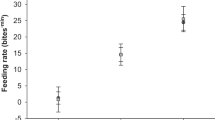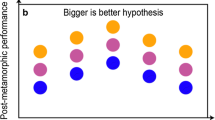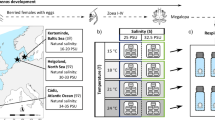Abstract
Temperature is an important factor affecting the distribution of freshwater fishes. The longfin dace (Agosia chrysogaster) is endemic to the Gila River basin of the southwestern USA and northern Mexico and occupies a range of thermal environments from cool mountain tributaries to warm desert rivers but information about its thermal biology is limited, particularly for larvae. We quantified the effect of rearing temperature on survival, growth capacity, and critical thermal maximum (CTM) of larval longfin dace. Broodstocks of longfin dace were collected from two sites in the upper Gila River in New Mexico from which larvae were hatched and reared for 22 days in indoor aquaria at constant temperatures ranging from 18.0 to 31.0 °C. Growth capacity peaked at 27.0 °C and was 21 % greater for larvae hatched from the upstream compared to the downstream broodstock, indicating intraspecific variability in growth capacity. CTM increased with rearing temperature and ranged from 33.9 to 39.9 °C, indicating that thermal acclimation influences maximum thermal tolerance. CTM and acclimation response ratio of larvae are lower than those of adult longfin dace measured in a previous study, suggesting that larvae are more sensitive and less responsive to thermal stress than adults. Water temperatures in 2012 from six sites in the upper Gila River basin did not exceed 27.0 °C and larval growth capacities in May of 2012 ranged from 5 to 28 % of the maximum growth capacity. We assert that rising temperatures may increase larval growth rates, although this will depend on resource limitation and shifts in community interactions.





Similar content being viewed by others
References
Alvarez D, Cano JM, Nicieza AG (2006) Microgeographic variation in metabolic rate and energy storage of brown trout: countergradient selection or thermal sensitivity? Evol Ecol 20:345–363. doi:10.1007/s10682-006-0004-1
Angilletta MJ (2009) Thermal adaptation: a theoretical and empirical synthesis. Oxford University Press, London
Arnott SA, Chiba S, Conover DO (2006) Evolution of intrinsic growth rate: metabolic costs drive tradeoffs between growth and swimming performance in Menidia menidia. Evolution 60:1269–1278
Baumann H, Conover DO (2011) Adaptation to climate change: contrasting patterns of thermal-reaction-norm evolution in Pacific versus Atlantic silversides. Proc R Soc B 278:2265–2273. doi:10.1098/rspb.2010.2479
Beitinger TL, Bennett WA, McCauley RW (2000) Temperature tolerances of North American freshwater fishes exposed to dynamic changes in temperature. Environ Biol Fishes 58:237–275.
Bennett WA, Beitinger TL (1997) Temperature tolerance of the sheepshead minnow, Cyprinodon variegates. Copeia 1997:7787
Bestgen KR (2008) Effects of water temperature on growth of Razorback Sucker larvae. West N AM Naturalist 68:15–20. doi:10.3398/1527-0904(2008)68[15:EOWTOG]2.0.CO;2
Brett JR (1956) Some principles in the thermal requirements of fishes. Q Rev Biol 31:75–88
Brown JH, Gillooly JF, Allen AP, Savage VM, West GB (2004) Toward a metabolic theory of ecology. Ecology 85:1771–1789. doi:10.1890/03-9000
Buisson L, Thuiller W, Lek S, Lim P, Grenouillet G (2008) Climate change hastens the turnover of stream fish assemblages. Glob Chang Biol 14:2232–2248. doi:10.1111/j.1365-2486.2008.01657.x
Caissie D (2006) The thermal regime of rivers: a review. Freshw Biol 51:1389–1406. doi:10.1111/j.1365-2427.2006.01597.x
Carveth CJ, Widmer AM, Bonar SA (2006) Comparison of upper thermal tolerances of native and nonnative fish species in Arizona. Trans Am Fish Soc 135:1433–1440. doi:10.1577/T05-025.1
Claussen DL (1977) Thermal acclimation in ambystomatid salamanders. Comp Biochem Physiol 58:333–340
Culumber ZW, Monks S (2014) Resilience to extreme temperature events: acclimation capacity and body condition of a polymorphic fish in response to thermal stress. Biol J Linn Soc. doi:10.1111/bij.12230
Davis AJ, Lawton JH, Shorrocks B, Jenkinson LS (1998) Individualistic species responses invalidate simple physiological models of community dynamics under global environmental change. J Anim Ecol 67:600–612. doi:10.1046/j.1365-2656.1998.00223.x
Deacon JE, Schumann PB, Stuenkel EL (1987) Thermal tolerances and preferences of fishes of the Virgin River (Utah, Arizona, Nevada). Great Basin Nat 47:538–546
Einum S, Fleming IA (1999) Maternal effects of egg size in brown trout (Salmo trutta): norms of reaction to environmental quality. Proc R Soc B 266:2095–2100. doi:10.1098/rspb.1999.0893
Fangue NA, Hofmeister M, Schulte PM (2006) Intraspecific variation in thermal tolerance and heat shock protein gene expression in common killifish, Fundulus heteroclitus. J Exp Biol 15:2859–2872. doi:10.1242/jeb.02260
Grimm NB (1988) Feeding dynamics, nitrogen budgets, and ecosystem role of a desert stream omnivore, Agosia chrysogaster (Pisces, Cyprinidae). Environ Biol Fish 21:143–152. doi:10.1007/BF00004849
Heggberget TG (1988) Timing of spawning in Norwegian Atlantic salmon (Salmo salar). Can J Fish Aquat Sci 45:845–849
Hokanson KE, McCormick JH, Jones BR (1973) Temperature requirements for embryos and larvae of northern pike, Esox lucius (Linneaus). Trans Am Fish Soc 102:89–100. doi:10.1577/1548-659(1973)102<89:TRFEAL>2.0.CO;2
Kinne O (1962) Irreversible nongenetic adaptation. Comp Biochem Physiol 5:265–282. doi:10.1016/0010-406X(62)90056-7
LeBlanc RT, Brown RD, FitzGibbon JE (1997) Modeling the effects of land use change on the water temperature in unregulated urban streams. J Environ Manag 49:445–469. doi:10.1006/jema.1996.0106
Lewis MA (1978) Notes on the natural history of the Longfin dace, Agosia chrysogaster, in a desert rheocrene. Copeia 1978:703–705
Lutterschmidt WI, Hutchison VH (1997) The critical thermal maximum: history and critique. Can J Zool 75:1561–1574. doi:10.1139/z97-783
Lyons J, Stewart JS, Mitro M (2010) Predicting the effects of climate warming on the distribution of 50 stream fishes in Wisconsin, U.S.A. J Fish Biol 77:1867–1898. doi:10.1111/j.1095-8649.2010.02763.x
MacNutt MJ, Hinch SG, Farrell AP, Topp S (2004) The effect of temperature and acclimation period on repeat swimming performance of cutthroat trout. J Fish Biol 65:342–353. doi:10.1111/j.1095-8649.2004.00453.x
Matthews WJ, Gido KB, Garrett GP, Gelwick FP, Stewart J, Schaefer J (2006) Modular experimental riffle-pool stream system. Trans Am Fish Soc 135:1559–1566. doi:10.1577/T05-202.1
Minckley WL, Barber WE (1971) Some aspects of the biology of Longfin Dace, a cyprinid fish characteristic of streams in the Sonoran Desert. Southwest Nat 15:459–464
Minckley WL, Deacon JE (1968) Southwestern fishes and enigma of endangered species. Science 159:1424–1432. doi:10.1126/science.159.3822.1424
Morgan IJ, McDonald DG, Wood CM (2001) The cost of living for freshwater fish in a warmer, more polluted world. Glob Chang Biol 7:345–355. doi:10.1046/j.1365-2486.2001.00424.x
Myrick CA, Cech JJ (2000) Swimming performance of four California stream fishes: temperature effects. Environ Biol Fish 58:289–295. doi:10.1023/A:1007649931414
Otto RG (1973) Temperature tolerance of mosquito fish, Gambusia affinis (Baird and Girard). J Fish Biol 5:575–585
Paroz YM, Propst DL, Stefferud JA (2006) Long-term monitoring of fish assemblages in the Gila River drainage, New Mexico. http://www.wildlife.state.nm.us/conservation/documents/PERMANENTSITESSYNTHESISFinal.pdf
Piffady JY, Souchon H, Capra PE (2010) Quantifying the effects of temperature and flow regime on the abundance of 0+ cyprinids in the upper River Rhone using Bayesian hierarchical modeling. Freshw Biol 55:2359–2374. doi:10.1111/j.1365-2427.2010.02453.x
Pool TK, Olden JD (2011) Taxonomic and functional homogenization of an endemic desert fish fauna. Divers Distrib 18:366–376. doi:10.1111/j.1472-4642.2011.00836.x
Poole GC, Berman CH (2001) An ecological perspective on in-stream temperature: natural heat dynamics and mechanisms of human caused degradation. Environ Manag 27:787–802. doi:10.1007/s002670010188
Rahel FJ, Hubert WA (1991) Fish assemblages and habitat gradients in a Rocky Mountain–Great Plains stream: biotic zonation and additive patterns of community change. Trans Am Fish Soc 120:319–332. doi:10.1577/1548-8659(1991)120<0319:FAAHGI>2.3.CO;2
Rombough PJ (1997) The effects of temperature on embryonic and larval development. In: Wood CM, McDonals DM (eds) Global warming: implications for freshwater and marine fish. Cambridge University Press, Cambridge, pp 177–224
Schaefer JF (2012) Hatch success and temperature-dependent development time in two broadly distributed topminnows (Fundulidae). Naturwissenschaften 99:591–595. doi:10.1007/s00114-012-0936-y
Schaefer JF, Ryan A (2006) Developmental plasticity in the thermal tolerance of zebrafish Danio rerio. J Fish Biol 69:722–734. doi:10.1111/j.1095-8649.2006.01145.x
Schaefer JF, Walters A (2010) Metabolic cold adaptation and developmental plasticity in metabolic rates among species in the Fundulus notatus species complex. Funct Ecol 24:1087–1094. doi:10.1111/j.1365-2435.2010.01726.x
Taniguchi Y, Nakano S (2000) Condition-specific competition: implications for the altitudinal distribution of stream fishes. Ecology 81:2027–2039. doi:10.1890/0012-9658(2000)081[2027:CSCIFT]2.0.CO;2
Velez-Espino LA, Fox MG, McLaughlin RL (2006) Characterization of elasticity patterns of North American freshwater fishes. Can J Fish Aquat Sci 63:2050–2066. doi:10.1139/F06-093
Wankowski JW (1979) Morphological limitations, prey size selectivity, and growth response of juvenile Atlantic salmon, Salmo salar. J Fish Biol 14:89–100
Wenger SJ, Isaak DJ, Luce CH, Neville HM, Fausch KD, Dunham JB, Dauwalter DC, Young MK, Elsner MM, Rieman BE, Hamlet AF, Williams JE (2011) Flow regime, temperature, and biotic interactions drive differential declines in trout species under climate change. Proc Natl Acad Sci 108:14175–14180. doi:10.1073/pnas.1103097108
Werner EE, Gilliam JF (1984) The ontogenetic niche and species interactions in size structured populations. Annu Rev Ecol Syst 15:393–425. doi:10.1146/annurev.es.15.110184.002141
Whitney JE (2010) Relationships among basal energy availability, nonnative predator success, and native fish declines in the upper Gila River Basin, NM, USA. Thesis, Kansas State University.
Widmer AM, Carveth CJ, Bonar SA, Simms JR (2006) Upper temperature tolerance of loach minnow under acute, chronic, and fluctuating thermal regimes. Trans Am Fish Soc 135:755–762. doi:10.1577/T04-205.1
Acknowledgments
We thank Josh Perkin for assistance with field collections, Michael Denk and Rebecca Zheng for assistance with experimental procedures and data collection, and Jake Schaefer for assistance with experimental design. The Konza Prairie Biological Station provided use of the experimental stream facility. This research was funded by the National Science Foundation (DEB#1311183), the Southwestern Association of Naturalists, Prairie Biotic Research Inc., the Kansas Academy of Science, and the Bureau of Reclamation Water Smart program. Longfin dace were collected and housed under the permission of the New Mexico Game and Fish Department (permit #3351), Konza Prairie Biological Station (permit ID#221) and the Institutional Animal Care and Use Committee (permit #2996)
Author information
Authors and Affiliations
Corresponding author
Rights and permissions
About this article
Cite this article
Troia, M.J., Whitney, J.E. & Gido, K.B. Thermal performance of larval longfin dace (Agosia chrysogaster), with implications for climate change. Environ Biol Fish 98, 395–404 (2015). https://doi.org/10.1007/s10641-014-0270-7
Received:
Accepted:
Published:
Issue Date:
DOI: https://doi.org/10.1007/s10641-014-0270-7




